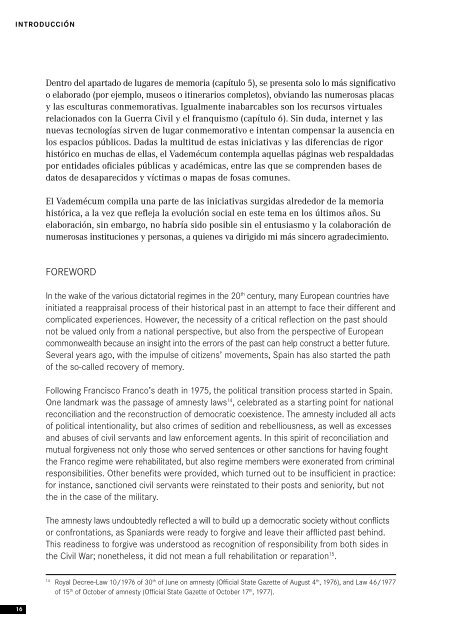Vademecum
Vademecum
Vademecum
Create successful ePaper yourself
Turn your PDF publications into a flip-book with our unique Google optimized e-Paper software.
INtRoduCCIóN<br />
16<br />
Dentro del apartado de lugares de memoria (capítulo 5), se presenta solo lo más significativo<br />
o elaborado (por ejemplo, museos o itinerarios completos), obviando las numerosas placas<br />
y las esculturas conmemorativas. Igualmente inabarcables son los recursos virtuales<br />
relacionados con la Guerra Civil y el franquismo (capítulo 6). Sin duda, internet y las<br />
nuevas tecnologías sirven de lugar conmemorativo e intentan compensar la ausencia en<br />
los espacios públicos. Dadas la multitud de estas iniciativas y las diferencias de rigor<br />
histórico en muchas de ellas, el Vademécum contempla aquellas páginas web respaldadas<br />
por entidades oficiales públicas y académicas, entre las que se comprenden bases de<br />
datos de desaparecidos y víctimas o mapas de fosas comunes.<br />
El Vademécum compila una parte de las iniciativas surgidas alrededor de la memoria<br />
histórica, a la vez que refleja la evolución social en este tema en los últimos años. Su<br />
elaboración, sin embargo, no habría sido posible sin el entusiasmo y la colaboración de<br />
numerosas instituciones y personas, a quienes va dirigido mi más sincero agradecimiento.<br />
ForEWorD<br />
in the wake of the various dictatorial regimes in the 20 th century, many European countries have<br />
initiated a reappraisal process of their historical past in an attempt to face their different and<br />
complicated experiences. However, the necessity of a critical reflection on the past should<br />
not be valued only from a national perspective, but also from the perspective of European<br />
commonwealth because an insight into the errors of the past can help construct a better future.<br />
Several years ago, with the impulse of citizens’ movements, Spain has also started the path<br />
of the so-called recovery of memory.<br />
Following Francisco Franco’s death in 1975, the political transition process started in Spain.<br />
one landmark was the passage of amnesty laws 14 , celebrated as a starting point for national<br />
reconciliation and the reconstruction of democratic coexistence. the amnesty included all acts<br />
of political intentionality, but also crimes of sedition and rebelliousness, as well as excesses<br />
and abuses of civil servants and law enforcement agents. in this spirit of reconciliation and<br />
mutual forgiveness not only those who served sentences or other sanctions for having fought<br />
the Franco regime were rehabilitated, but also regime members were exonerated from criminal<br />
responsibilities. other benefits were provided, which turned out to be insufficient in practice:<br />
for instance, sanctioned civil servants were reinstated to their posts and seniority, but not<br />
the in the case of the military.<br />
the amnesty laws undoubtedly reflected a will to build up a democratic society without conflicts<br />
or confrontations, as Spaniards were ready to forgive and leave their afflicted past behind.<br />
this readiness to forgive was understood as recognition of responsibility from both sides in<br />
the Civil War; nonetheless, it did not mean a full rehabilitation or reparation 15 .<br />
14 royal Decree-law 10/1976 of 30 th of June on amnesty (official State Gazette of August 4 th , 1976), and law 46/1977<br />
of 15 th of october of amnesty (official State Gazette of october 17 th , 1977).


